PHILADELPHIA—“Think about the worst thing you’ve ever done,” Professor Lori Pompa intones as class begins. Her students, here on the first day of an introductory criminal justice class at Temple University, sit for a moment in quiet reflection. “Now,” Pompa says, breaking the silence, “imagine what it would feel like to be judged forever by that experience.”
This first-day lesson in humility marks the students’ entry into the Inside-Out Prison Exchange Program, an innovative educational effort that operates at what might seem an odd nexus: the juncture of academia and the correctional system.
As the program’s name implies, students in Pompa’s semester-long course won’t learn all of their lessons in the classroom—certainly not the most profound ones. And no grade or portfolio can adequately demonstrate what these students will gain in the weeks ahead.
Inside-Out allows undergraduates at Temple, St. Joseph’s University and other Philadelphia postsecondary institutions to become classmates with men and women on the “inside”—that is, those being held in area correctional facilities.
The 15-week course that started it all, “Exploring Issues of Crime and Justice Behind the Walls,” was first offered at Temple in 1997. Since then, the Inside-Out Prison Exchange Program has grown to include more than 300 courses being offered in schools and correctional institutions in 34 states as well as internationally. The courses, which cover a variety of disciplines and a wide range of subjects, all use what Pompa calls “the prism of prison” to explore the material. The courses are credit-bearing—for students on either side of the prison walls. Through wide-ranging discussions of literature, philosophy, psychology and criminal justice, participants gain personal insight and, ideally, a sense of their own potential.
A way to find meaning
A second facet of the program dispatches Inside-Out staff and college faculty into correctional facilities to moderate open-ended dialogues about the same subjects covered in the undergraduate classes. No one involved—whether inside or out, faculty or student—emerges from the program unchanged.
“The people serving a life sentence are the most inspiring people I have ever met because they have found meaning in a totally meaningless structure,” says Tricia Way, associate director of Inside-Out. Way leads a gender and masculinity course at the medium-security state correctional institution at Chester, a half-hour outside Philadelphia.
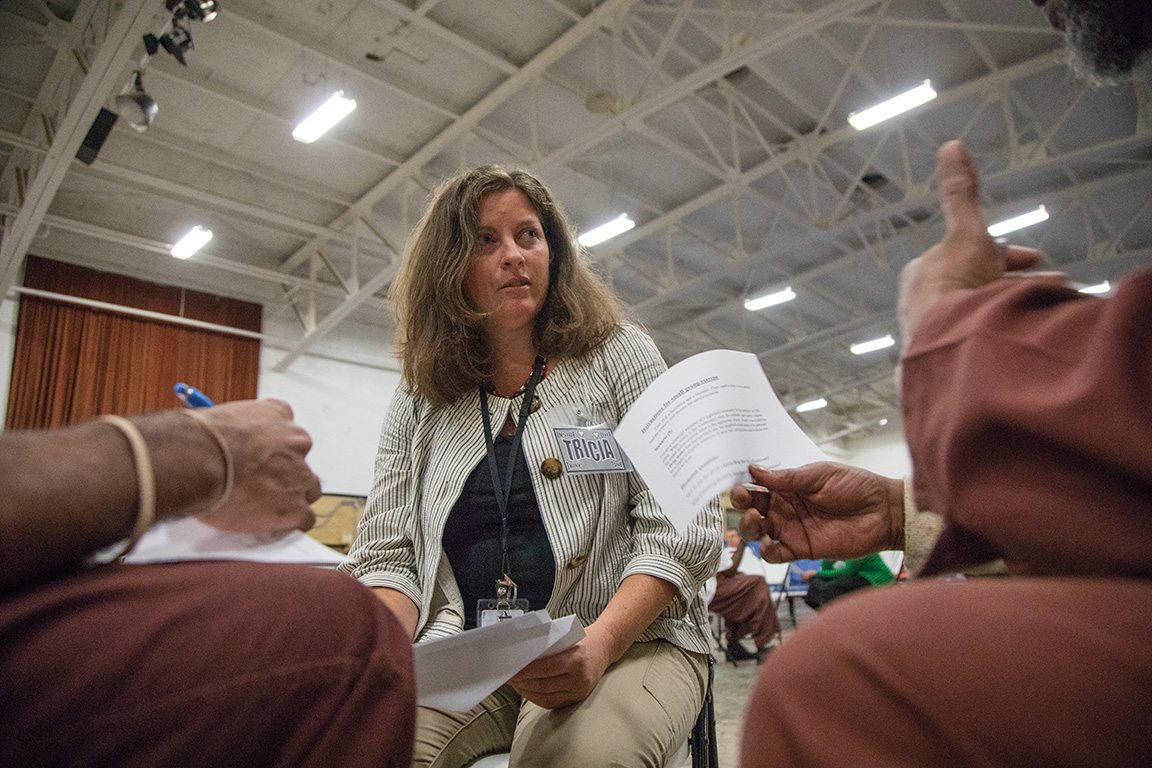
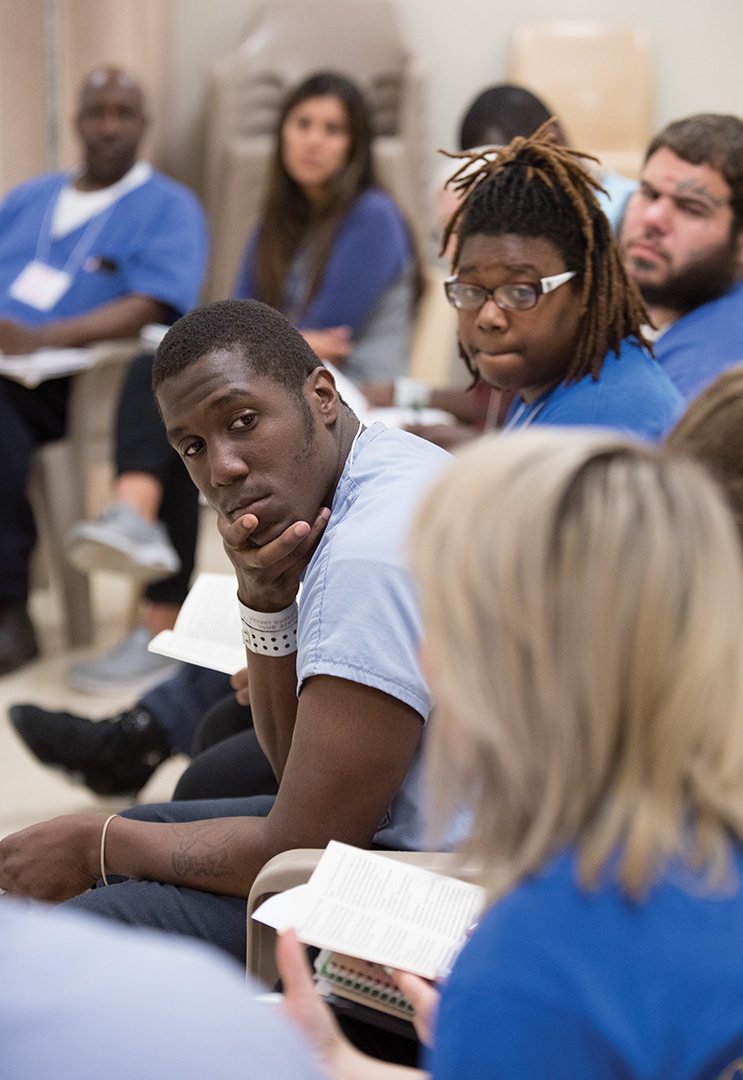
The program that thrust Way into this world behind walls has its origins in the early 1990s, when Pompa led her criminal justice students on visits to area jails. It was a conversation during one such visit—to the State Correctional Institution-Dallas, near Scranton, Pa.—that set the current model in motion.
Pompa moderated the exchange between her undergrads and the inmates. The discussion, she recalls, “very quickly became very deep and complex. Spending years incarcerated leads to a lot of reflection,” Pompa says. “Not just self-reflection, but reflections on justice and social systems. And that can go to places you don’t expect.”
The conversation had a profound effect on one person in particular, a man serving a life sentence.
“I’d been incarcerated about a decade,” recalls the inmate, Paul (the Pennsylvania Department of Corrections asks that the media not publish the last names of men and women actively serving time). “It was so liberating to know someone cared.”
After the discussion, Paul pulled Pompa aside to discuss the possibility of establishing a program to unite Temple students and the incarcerated on a weekly basis.
“You ever see how a dog tips its head ever so slightly?” Paul asks. That was Pompa’s response.
“I told him I’d think about it,” recalls Pompa. “And I couldn’t do anything but think about it.”
Five years later, following an equally intense student-inmate dialogue at the Graterford State Correctional Institution, a maximum-security facility an hour northwest of Philadelphia, Pompa found herself in a strikingly similar conversation with another inmate: Tyrone Werts, president of the prison’s “Lifers Organization.” Werts recommended that Pompa formally present a plan to implement an ongoing student-inmate program to the Temple administration. For his part, Werts said he’d try to sell the idea to officials at Graterford. He assumed that increasing the faculty presence inside wouldn’t pose a problem, but he worried that officials would balk at the idea of facilitating regular interaction between college students and hard-core felons.
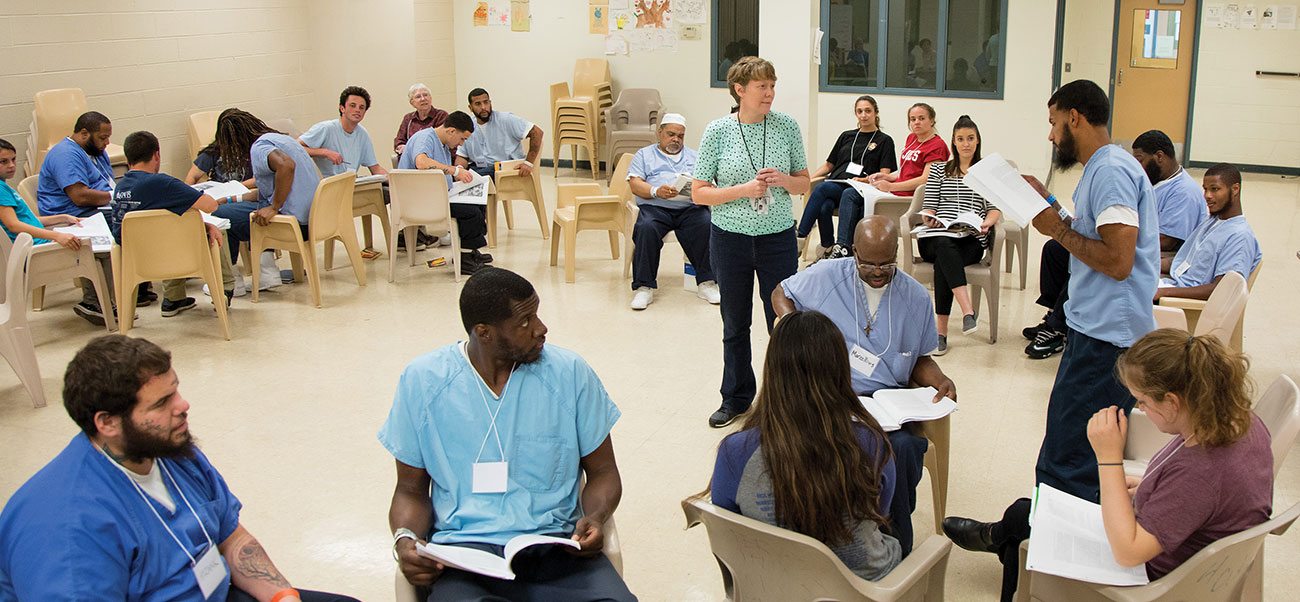
Then 53, Werts was 30 years into a sentence of life without parole for his ancillary part in a botched 1975 robbery that led to the murder of a Philadelphia man.
He’d put the time to good use, earning a high school equivalency diploma followed by an undergraduate degree from Villanova University. His education wasn’t limited to books; the years also had taught him how the system works. Werts knew that written proposals tended to get lost in the bureaucratic shuffle and that his best strategy was to leverage his stature as a prison leader to discuss the matter personally with officials at every level of the Graterford hierarchy.
He made his pitch and braced for the worst, thinking: “There’s no way a maximum-security prison would let a group of students through the gates on a weekly basis.”
It turned out, Werts had sold himself and the prison short. Graterford approved the proposal quickly.
Soon after, Pompa received a congratulatory letter from a Graterford resident who’d conferred with Werts as he lobbied prison officials. The writer was Paul. Unbeknownst to Pompa, he’d been transferred to Graterford since raising the prospect of a student-prison education program while incarcerated at Dallas.
New twist on ‘town and gown’
On a late September afternoon a decade and a half later, 16 St. Joseph’s University (SJU) undergraduates stepped off mini-buses at the Cambria Community Center, a minimum-security unit operated by the Philadelphia Prison System. The unit is located in a complex a short drive from the Main Line campus of the 8,600-student Jesuit university.
Over the next few hours, the SJU contingent furthered the mission envisioned by Pompa, Werts and Paul. Passing through two secured doors, the students entered an all-purpose room where they were greeted by an equal number of residents at Cambria, a work-development facility for men serving sentences of up to 23 months.
In a new twist on “town and gown,” students and inmates (all identified here by first name only), promptly occupied alternate seats in a circle of chairs, “inside” participants seated next to those from the “outside.”
Yaa, an SJU senior, plopped next to her “best friend,” a heavily-tattooed inmate called Frank.
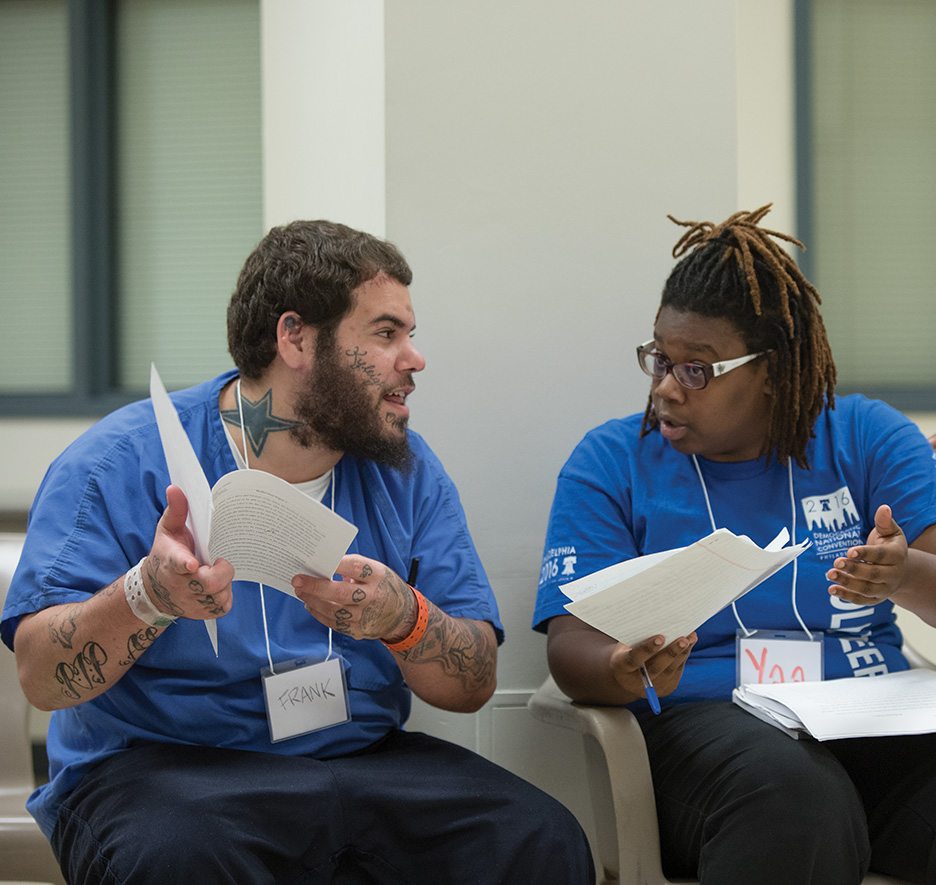
An English major with a double minor in Spanish and Latin American studies, Yaa disclosed plans to enroll in law school following graduation.
“Will you bust me outta here?” Frank asked, drawing a giggle.
McNeil, another SJU student, had little exposure to the criminal justice system when she enrolled in “Dimensions of Freedom,” the Inside-Out course introduced in 2009 to students pursuing philosophy or general education credits in a nontraditional elective. Just four weeks into the semester, this interactive class that examines freedom through the lenses of literature, philosophy and psychology had already imparted lessons that McNeil will carry the rest of her life.
“I’ve learned I can relate to people on every level,” she says. “I never thought I’d find that out about myself in a men’s prison. But they bring up ideas in a different plane—and in a world I hope I never have to experience personally.”
SJU philosophy Professor Elizabeth Linehan, who has co-taught “Dimensions of Freedom” since its inception, witnesses similar epiphanies every semester the course is offered.
“They never think of incarcerated people in the same way again,” says Linehan. “Instead of seeing (them) as dangerous or bad guys, they just see them as people.”
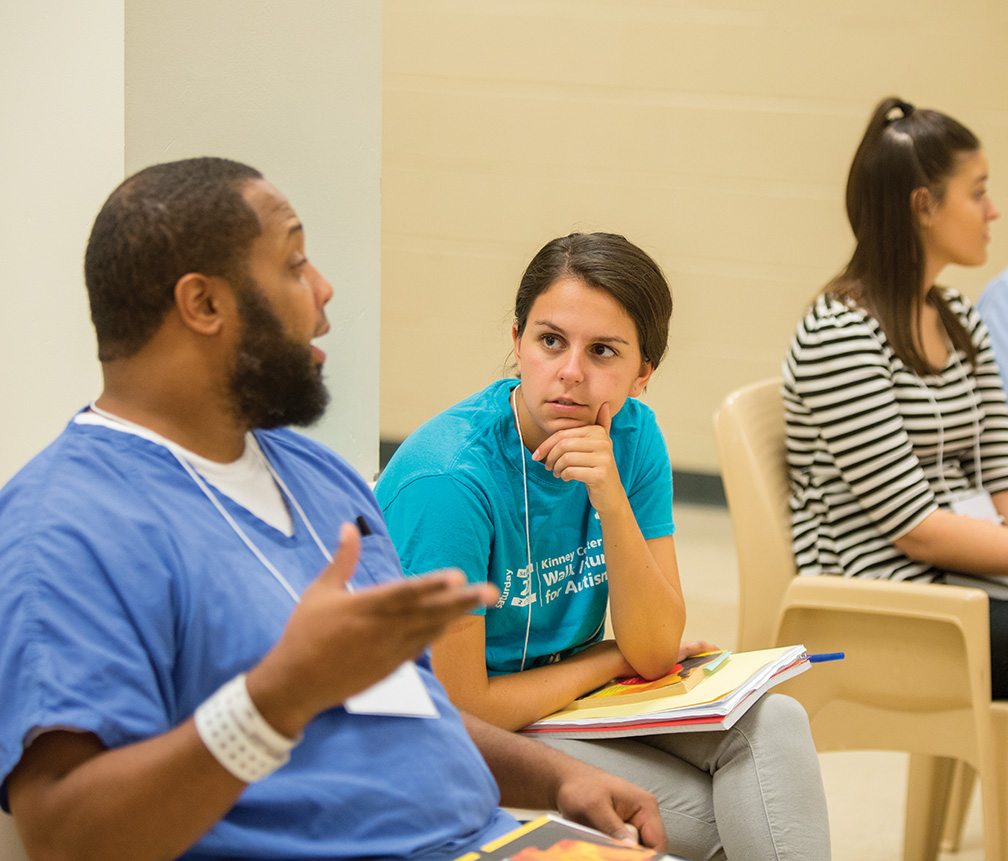
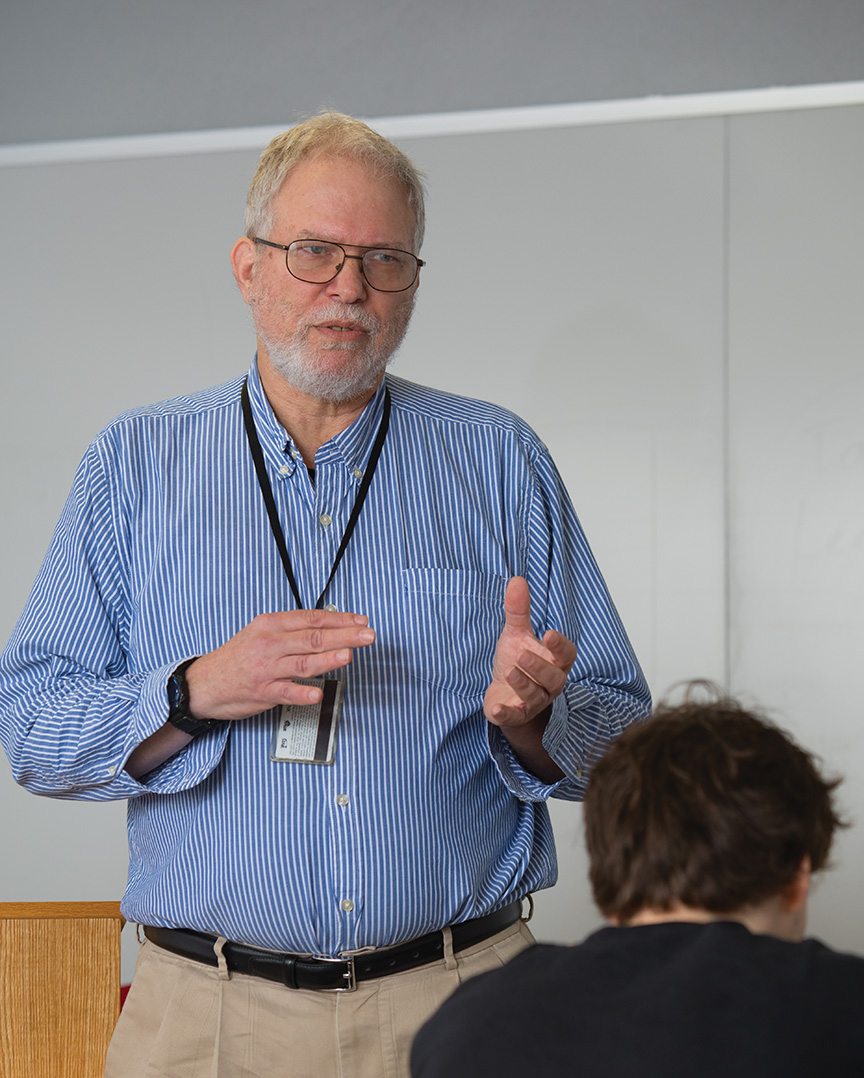
says the Inside-Out program “has recharged my batteries as far as teaching” and helped him adopt a dialogue-based approach in his regular, on-campus classes.
Kasie, a junior English major at SJU, says she sometimes struggles to explain to family and friends how the men she has met at Cambria are no better or worse than anyone else. “They just don’t understand that the people here are just as smart or smarter than I am,” says Kasie.
The easy banter between Yaa and Frank continued as SJU English Professor Ann Green walked the group through a reading and interpretation of Slick and the Beanstalk. Equal parts maddening and mirthful, the inmate-written essay draws a line between the nurturing of a bean plant and the absurdity of petty institutional rules.
To Frank, the essay clarified the idea that freedom is little more than a state of mind. In the same way, the Inside-Out construct gives Frank another type of liberation.
“Your brain becomes mush if you don’t use it,” he says.
In addition to course content, Inside-Out strives to spark self-awareness and personal growth. Jerry Stahler, a professor in the Geography and Urban Studies department at Temple University, was among the first faculty members to venture from campus to prison.
His area of expertise—substance abuse—holds special relevance for students studying the web of connections between drugs and prison.
“(Inside-Out) has recharged my batteries as far as teaching,” Stahler says. “Now, when I’m on campus, I draw on pedagogic lessons from Inside-Out in my classrooms. It has moved me toward a dialogue-based approach. And I’ve moved that way because of Inside-Out.”
Kristi Polizzano is another who credits Inside-Out for a personal transformation. Polizzano arrived at Temple as a pre-med student in 2011, a career path that eventually morphed into a major in psychology with a minor, criminal science, that landed her in Pompa’s class.
Nervous and anxious on the first trip from North Philly to Graterford, Polizzano felt her anxiety dissipate the instant she cleared security. By the time Polizzano arrived at the classroom, her apprehension was forgotten. Trepidation has a way of “falling away layer by layer after you come into that room,” says Pompa.
Polizzano was leaning toward law school as graduation approached, but the emotional wallop of a late-semester visit to Graterford turned her career arc in a whole new direction.
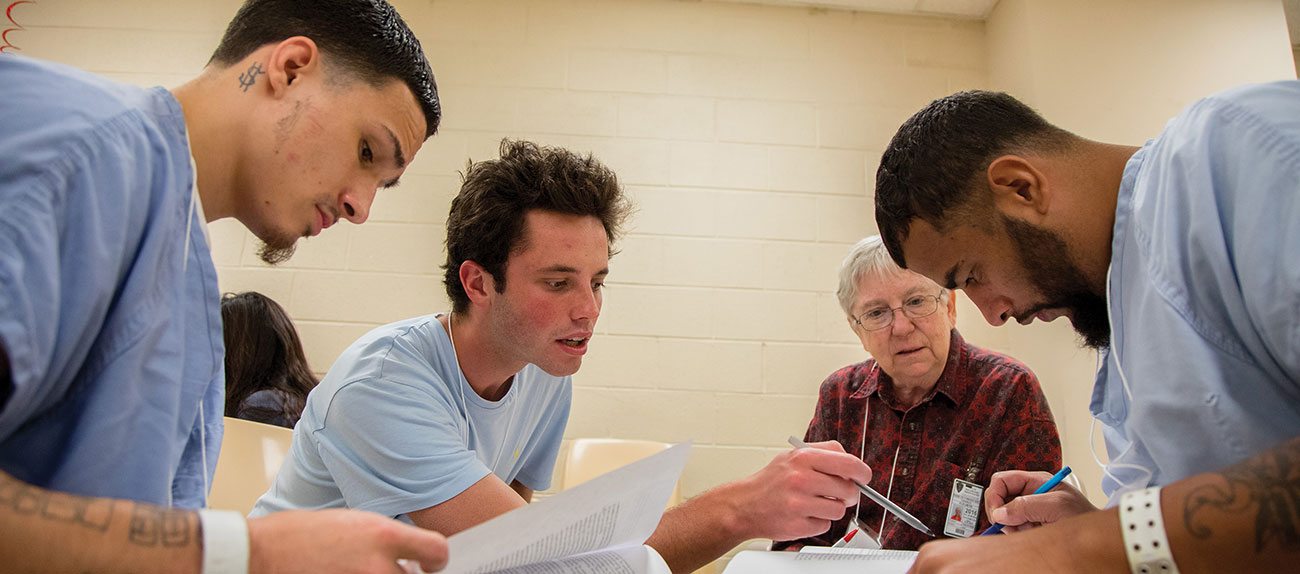
“I realized I was in the perfect position to change paths,” Polizzano recalls. Forsaking her plans, she instead went to work as an intern in the Inside-Out office. Since then, a series of promotions have led to her current role: coordinating the instructor and student exchanges at Graterford and other corrections units in the Philadelphia vicinity.
A national champion in the sport of powerlifting, Polizzano has also introduced the sport to many Graterford inmates. Meanwhile, she’s also forged a close relationship with an Inside-Out co-worker who took a decidedly different path to the program office: Tyrone Werts, the former “lifer” who helped get the program going at Graterford.
Tracing a changed life
Werts is on the outside for good now, having been released in 2011 when his sentence was commuted by then-Gov. Ed Rendell. His past is clearly past, but the story is worth recounting in some detail.
It began on the evening of May 6, 1975, when Werts set out with three North Philly neighborhood friends to rob a drug dealer. Werts was 23 and recently married, a new father working to support his family as a mechanic—while struggling to end a pattern of petty crimes that had frequently landed him behind bars for short stays.
On this night, thanks to his disastrous decision to join his friends, that pattern of short jail stints indeed ended. Instead, Werts careened down a path toward long-term confinement.
Unable to find a dealer, the five men decided to rob the patrons of a neighborhood gambling house, known in Philly street parlance as a “speakeasy.” What they intended as a robbery ended with the slaying of a speakeasy customer.
Werts, who had remained in the car throughout the episode, turned down a plea deal. Reasoning that
“I never got out of the car, I never touched a weapon,” Werts opted for a trial by jury.
His strategy backfired. Convicted of second-degree murder, he was sentenced under a section of the Pennsylvania criminal code that allows homicide accomplices to be sentenced to life without parole.
Remanded to Graterford, Werts at first fixated on a single thought: “How am I going to get out of this horrific place?”
The question nagged at him until a motivational speaker visiting the prison issued a challenge to Werts. Promise me, the speaker told him, “that as long as you are here that you do everything you can to make a good life for yourself.”
The words resonated.
“I started seeing myself in a different way,” Werts says.
Drawing on a new outlook, Werts threw himself into earning his high school equivalency certificate. Not only did he pass the GED test on the first try, he recorded the highest score in class. The diploma became a springboard to a series of successes: an undergraduate degree from Villanova University (“in one semester my mind expanded like I’d never known”), the Graterford leadership position, the implementation of Inside-Out, and the 2011 commutation of his sentence.
Now 65, Werts’ official title is National Think Tank Coordinator for Inside-Out, and he remains a fierce advocate of prison-based education. “Inside-Out changed my life,” he says. “It cracked me open and revealed things about me that I didn’t know myself. I grew immensely.”
Thirty-six years after he departed his hometown in a prison van, Tyrone Werts returned to Philadelphia and took an Inside-Out leadership position, a job that he says “humbles me.” After spending most of his adult life in a maximum-security prison cell, Werts now reports each morning to an office on the Temple campus, three miles north of the Liberty Bell.
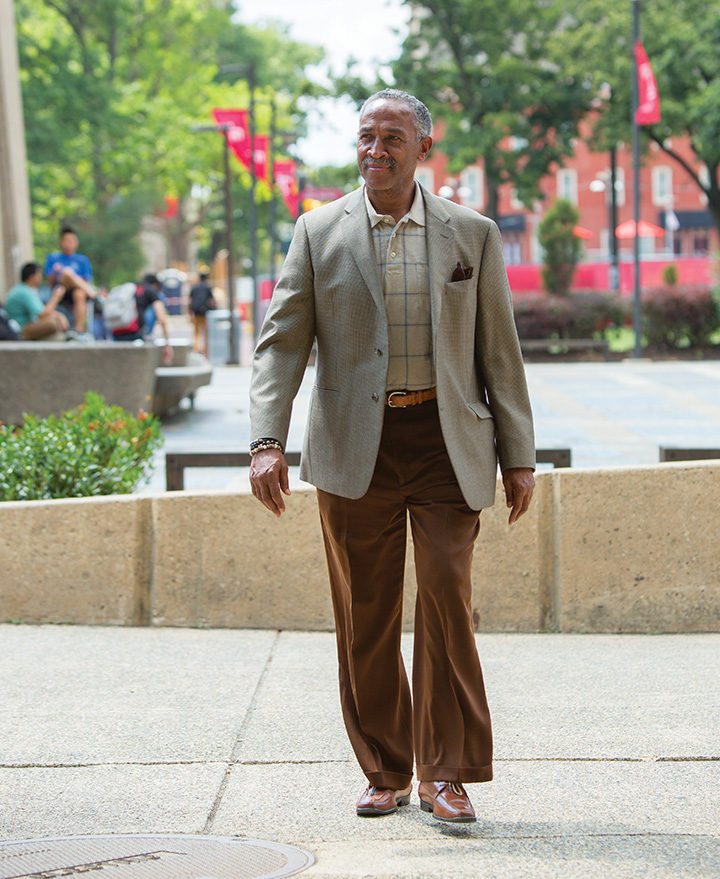
Having spent the better part of four decades at Graterford, Werts could be excused for never returning. But he revisits regularly to discuss issues arising from life-without-parole sentences. The Graterford visits offer Werts an opportunity to rekindle friendships—none deeper or more enduring than the one with the man who shared his original vision of a prison-based education program.
Today, the relationship between Tyrone Werts and Paul is tinged with poignancy. When the meetings end, Werts heads to his car for the drive home to Philadelphia; Paul is ushered, under guard, back to a cell.
Barring gubernatorial commutation, Paul will never leave Graterford. He’s still being defined by the worst thing he’s ever done. But, true to the subtext of Pompa’s first-day lesson, that’s not how Paul defines himself.
“We learn in Inside-Out that it doesn’t matter what you’ve done in life,” he says. “It’s where you are in life. We all have a voice. And that voice is worth hearing.”
![]()
